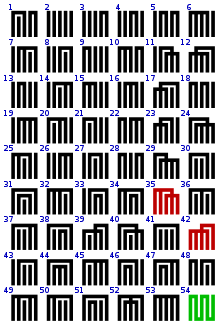54 (number)
| ||||
|---|---|---|---|---|
| Cardinal | fifty-four | |||
| Ordinal |
54th (fifty-fourth) | |||
| Factorization | 2 × 33 | |||
| Divisors | 1, 2, 3, 6, 9, 18, 27, 54 | |||
| Roman numeral | LIV | |||
| Binary | 1101102 | |||
| Ternary | 20003 | |||
| Quaternary | 3124 | |||
| Quinary | 2045 | |||
| Senary | 1306 | |||
| Octal | 668 | |||
| Duodecimal | 4612 | |||
| Hexadecimal | 3616 | |||
| Vigesimal | 2E20 | |||
| Base 36 | 1I36 | |||
| Look up fifty-four in Wiktionary, the free dictionary. |
54 (fifty-four) is the natural number following 53 and preceding 55.
In mathematics
54 is a 19-gonal number.[1] Twice the third power of three, 54 is a Leyland number.[2] 54 can be written as the sum of three squares in three different ways: 72 + 22 + 12 = 62 + 32 + 32 = 52 + 52 + 22 = 54. It is the smallest number with this property. Like all other multiples of 6, it is a semiperfect number.[3]
In base 10, 54 is a Harshad number.[4]
The Holt graph has 54 edges.
The sine of an angle of 54 degrees is half the golden ratio.
The factorial of 54 is 230843697339241380472092742683027581083278564571807941132288000000000000, or approximately 2.30843697339241×1071.
In science
- The atomic number of xenon is 54.
Astronomy
- Messier object M54, a magnitude 8.5 globular cluster in the constellation Sagittarius
- The New General Catalogue object NGC 54, a spiral galaxy in the constellation Cetus
- The number of years in three Saros cycles of eclipses of the sun and moon is known as a Triple Saros or exeligmos (Greek: "turn of the wheel").
- The Saros number of the solar eclipse series which began on -1284 July 25 and ended on 32 September. The duration of Saros series 54 was 1316.2 years, and it contained 74 solar eclipses.
- The Saros number of the lunar eclipse series which began on -964 May 14 and ended on 334 July. The duration of Saros series 54 was 1298.1 years, and it contained 73 lunar eclipses.
In sports
- Fewest points in an NBA playoff game: Chicago (96), Utah (54), June 7, 1998
- The New York Rangers won the Stanley Cup in 1994, 54 years after their previous Cup win. It is the longest drought in the trophy's history.
- For years car number 54 was driven by NASCAR's Lennie Pond. More recently, it is known as the Nationwide Series car number for Kyle Busch.
- A score of 54 in golf is colloquially referred to as a perfect round. This score has never been achieved in competition.
- The number used when a player is defeated 3 games in a row in racquetball.

A Rubik's Cube has 54 colored squares

Traditional Japanese symbols of the 54 chapters of the Tale of Genji
In other fields
54 is also:
- The number of milligrams of caffeine in 12 ounces of Mountain Dew.
- +54 The code for international direct dial phone calls to Argentina
- Municipal Okrug 54, a municipal okrug of Nevsky District of Saint Petersburg, Russia
- A broadcast television channel number
- 54, a 1998 film about Studio 54 starring Ryan Phillippe, Mike Myers, and Salma Hayek
- 54, a novel by the Wu Ming collective of authors
- In the title of a 1960s television show Car 54, Where Are You?
- The number of the French department Meurthe-et-Moselle
- New York's Warwick New York Hotel is on West 54th Street
- The number of cards in a deck of playing cards, if two jokers are included
- The number of countries in Africa
- Year identifier used on motor vehicles registered in the UK between 1 September 2004 and 28 February 2005
- Six by nine, the incorrect Answer to the Ultimate Question of Life, the Universe, and Everything
References
- ↑ "Sloane's A051871 : 19-gonal numbers". The On-Line Encyclopedia of Integer Sequences. OEIS Foundation. Retrieved 2016-05-30.
- ↑ "Sloane's A076980 : Leyland numbers". The On-Line Encyclopedia of Integer Sequences. OEIS Foundation. Retrieved 2016-05-30.
- ↑ "Sloane's A005835 : Pseudoperfect (or semiperfect) numbers". The On-Line Encyclopedia of Integer Sequences. OEIS Foundation. Retrieved 2016-05-30.
- ↑ "Sloane's A005349 : Niven (or Harshad) numbers". The On-Line Encyclopedia of Integer Sequences. OEIS Foundation. Retrieved 2016-05-30.
This article is issued from Wikipedia - version of the 9/30/2016. The text is available under the Creative Commons Attribution/Share Alike but additional terms may apply for the media files.